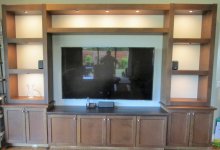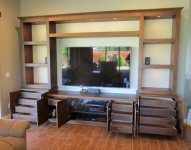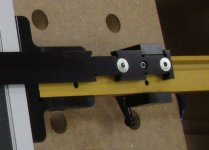Dick Mahany
Member
- Joined
- Jan 8, 2016
- Messages
- 555
This was my first project after downsizing my shop and selling my tablesaw. I am absolutely amazed at what can be done with a TS55 REQ, MFT3 and Domino 500. The cabinets are 12 feet wide and 8 feet tall and are made from maple and maple veneer ply. Doors are frame and panel stile/rail construction and made with a router table. Drawers were made with pre-finished Baltic Birch ply. All wiring for the LED puck lights and bookshelf speakers are concealed in the framework. I needed to match the finish on my kitchen cabinets in an adjacent room and used water borne stain, sealer and 10% sheen topcoats from Renner coatings and used a Fuji MM3 HVLP.
One thing that really helped to uniformly rip all of the 75mm face strips was the Seneca parallel guide set, which I modified with adjustable lever handles and brass tipped set screws which prevented them from creeping better than the stock knobs and nylon set screws.
Although I do miss my table saw, I won't buy another after seeing what the tracksaw and MFT3 combination can do. Sheet goods were broken down to cutlist dimensions in mere minutes with great accuracy. I just wish the tracksaw could plow dadoes.
[attachimg=3]
One thing that really helped to uniformly rip all of the 75mm face strips was the Seneca parallel guide set, which I modified with adjustable lever handles and brass tipped set screws which prevented them from creeping better than the stock knobs and nylon set screws.
Although I do miss my table saw, I won't buy another after seeing what the tracksaw and MFT3 combination can do. Sheet goods were broken down to cutlist dimensions in mere minutes with great accuracy. I just wish the tracksaw could plow dadoes.
[attachimg=3]




